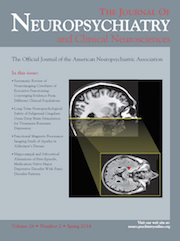Mania Secondary to Traumatic Brain Injury: a Case Report
To the Editor: Mood disorders after traumatic brain injury (TBI) occur at a greater frequency than in the general population with estimates approaching 25%‒50% for major depression, 15%‒30% for dysthymia, and 9% for mania.1 Despite common occurrence, there are relatively few studies that provide clear assistance about diagnosis and management of symptoms following TBI. Therefore, case reports have a significant role in the diagnosis, physiopathology, and management of mania after TBI. Here a case of mania secondary to TBI, which is successfully treated with olanzapine and valproate, is presented.
Case Report
“C.O.,” a 42-year-old man, presented to our hospital with complaints of insomnia, continuous speaking and walking, getting out of home, and trying to stop cars. After he had a head trauma 3 years ago, left hemiplegia occurred, and he had been referred to the neurology clinic with the complaints of impaired sleep pattern, inability to sit still, and wishing to smoke continuously. MRI showed minimal cortical atrophy and enlargement of the sulci; third and lateral ventricles were clear and bilaterally nonspecific T2 and flair hyperintensities were considered as microangiopatic ischemic gliotic focuses. EEG was also assessed as normal, and the patient was referred to the psychiatry unit. Family and personal history were unremarkable.
Physical and neurological examination revealed left hemiplegia and a little erase in the left nasolabial sulcus. On mental status examination, psychomotor activity, speech rate and amount were increased, associations were dispersed, and his affect was cheerful. Cognitive functions were diminished, and he had no insight. Mini-Mental State Examination (MMSE) score was 16 and Young Mani Scale (YMS) score was 28 in first assessment. The diagnosis of organic mood disorder was considered. On the 20th day, insomnia was improved, speech amount and rate decreased, and psychomotor activity-mobility was partially improved with olanzapine 15 mg/day and valproate 1,000 mg/day. Serum Valproate level was 72 pg/ml. YMS score decreased to 9, and he has been followed-up for 2 months in our outpatient clinic.
Discussion
In this man who had no prior psychiatric history, manic episode emerged after traumatic brain injury. A group of patients who had manic and depressive episodes after head trauma and another group who had only manic episodes were compared in a study. MMSE scores were lower in manic-depressive group than the other and in the imaging techniques; subcortical involvement was dominant in the manic depressive group and cortical involvement was dominant in manic group.2 In our case, MMSE score was 16; the third and lateral ventricles were a little dilated and hyperintense gliotic signal alterations in periventricular white matter in T2 scanning, cortical atrophy, and sulci enlargement bilaterally were similarly seen in older and new imagings. A diagnosis of mania secondary to head trauma should be considered in manic patients with atypical age of onset, cognitive decline, absence of previous psychiatric disorder negative family history for bipolar disorder.3 These group of patients might benefit early diagnosis and treatment in early neuronal damage process.
1 : Disorders of mood after traumatic brain injury. Semin Clin Neuropsychiatry 1998; 3:224–231Medline, Google Scholar
2 : Manic-depressive and pure manic states after brain lesions. Biol Psychiatry 1991; 29:149–158Crossref, Medline, Google Scholar
3 : Secondary mania: manic syndromes associated with antecedent physical illness or drugs. Arch Gen Psychiatry 1978; 35:1333–1339Crossref, Medline, Google Scholar



